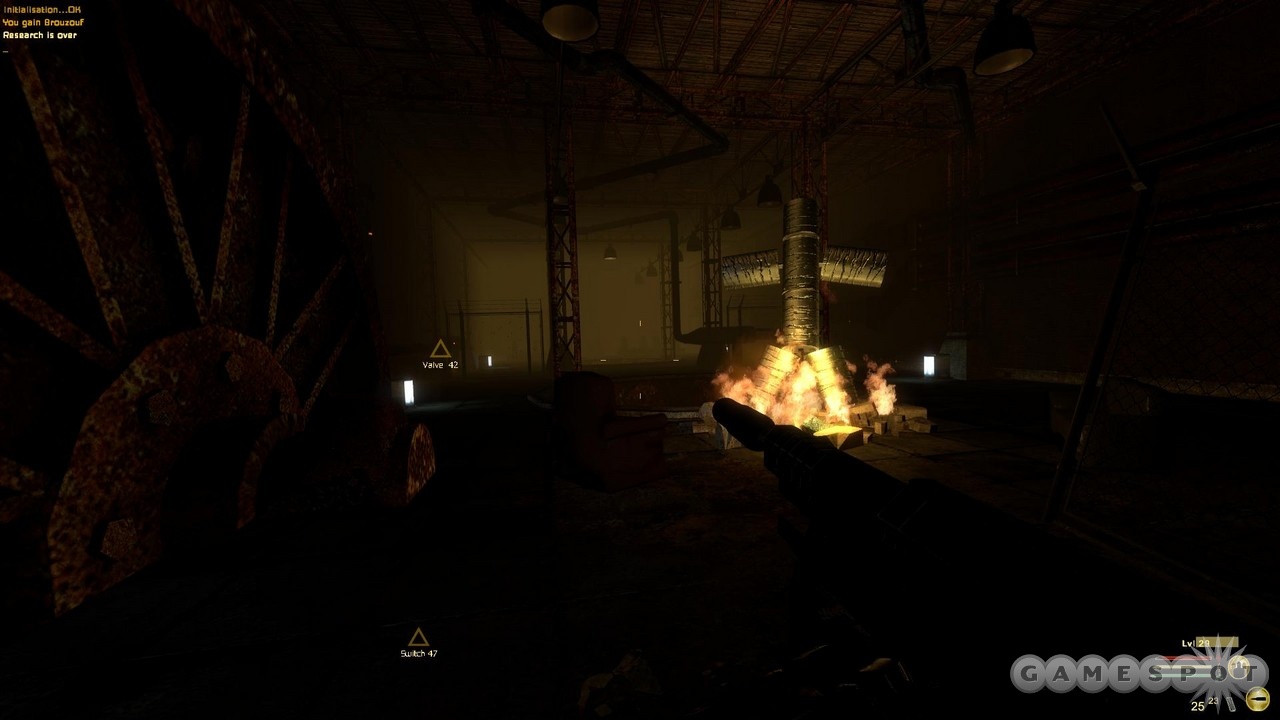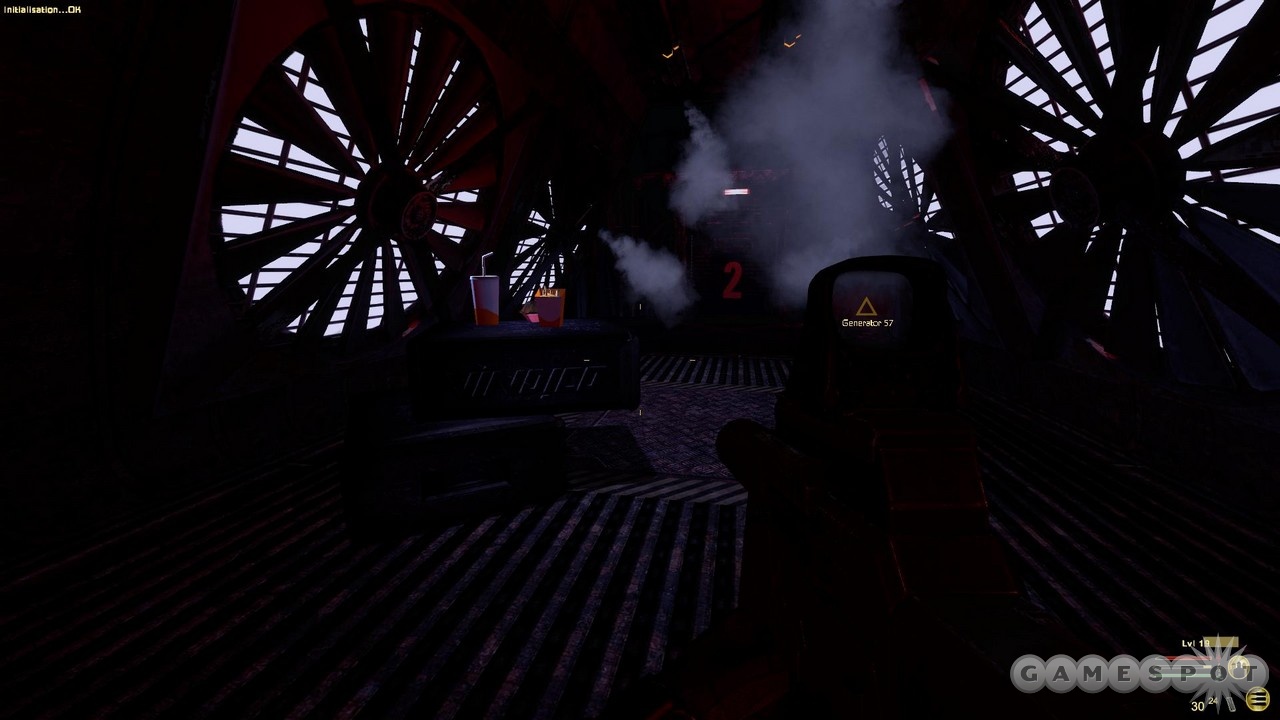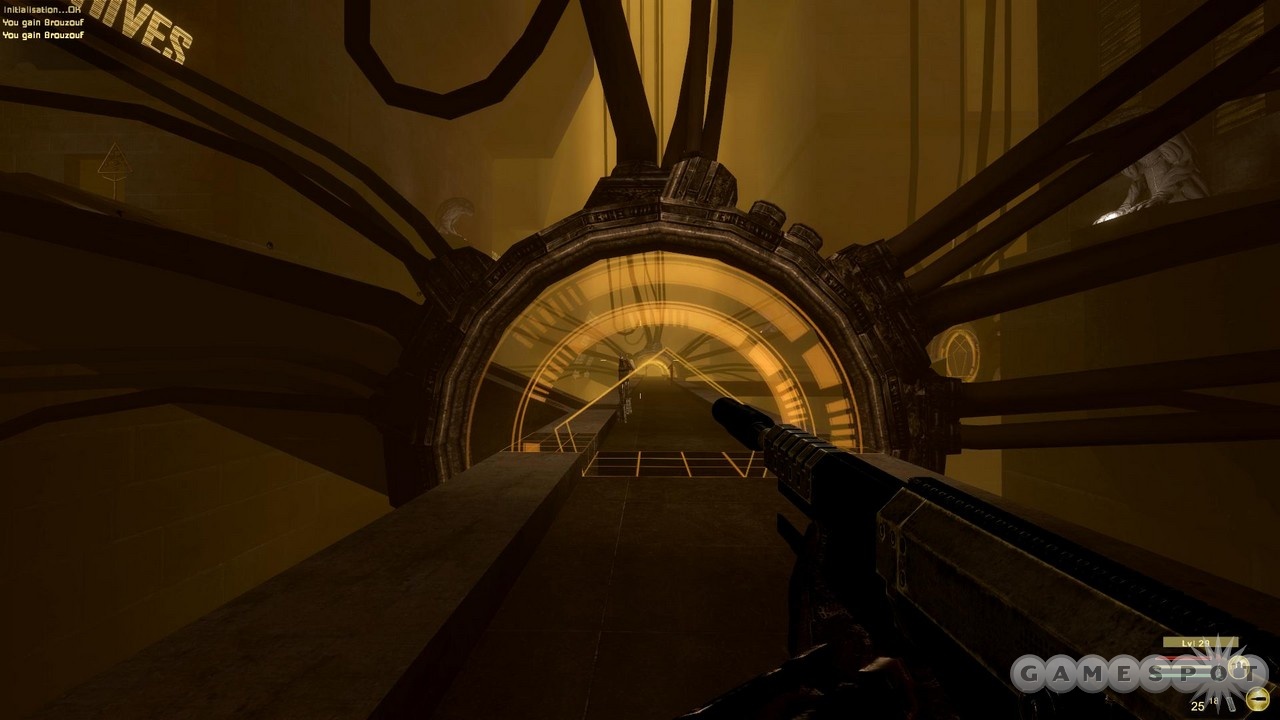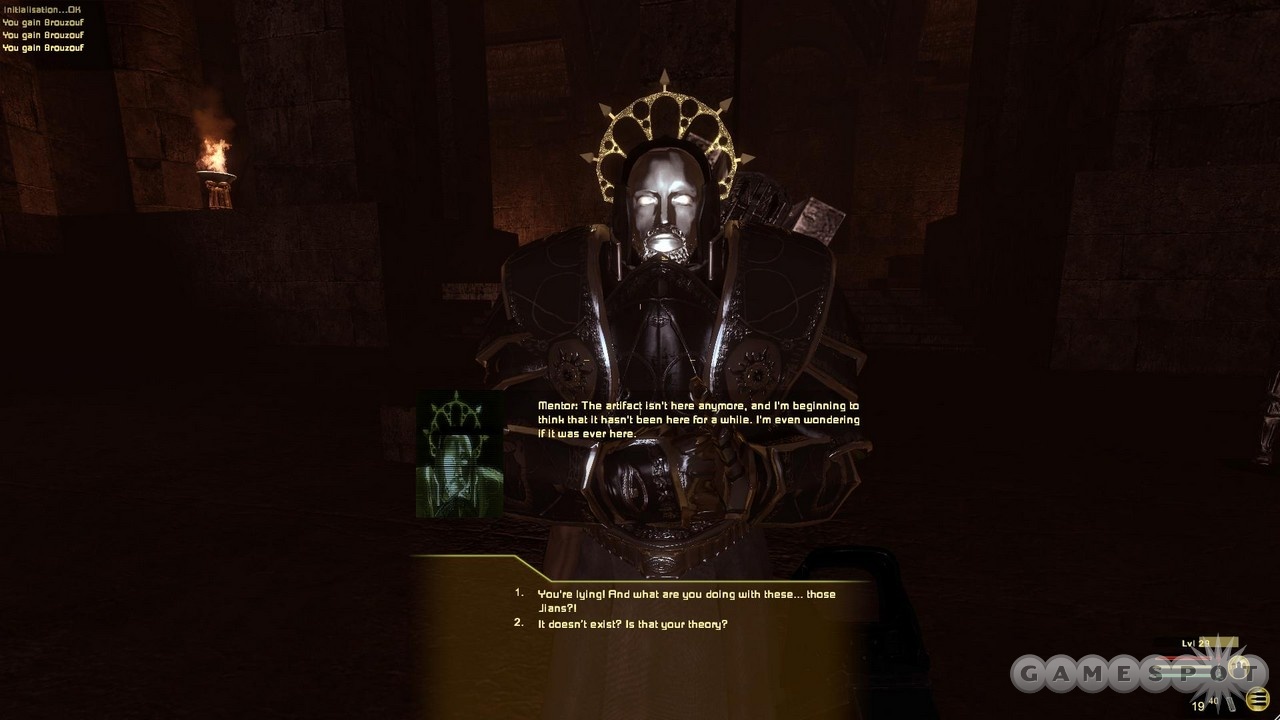E.Y.E.: Divine Cybermancy is an unusual, engrossing, and maddening game that is unmistakably itself. This first-person role-playing action game may be painted with shades of Deus Ex, but its atmosphere and pace are unique, and this uniqueness keeps you engaged in the face of some uninviting elements. E.Y.E. is ambitious. It hands you guns, swords, and cybernetic skills, and then drops you into a chilling sci-fi world, letting you accomplish your goals in any way you see fit. It's also confusing and awkward, dropping unnecessary obstacles in your path proudly, as if to say, "These aren't bugs; they're features!" And so you might sometimes curse and grit your teeth, but you will also be entertained and perhaps even in awe at times. Once you've played E.Y.E., you aren't apt to forget it. Whether you remember it more for its oppressive futuristic ambience and impressive flexibility, or for how hard it works to alienate its own players, depends largely on how much patience you have.
It's a shame that E.Y.E.: Divine Cybermancy demands so much of that patience from the get-go. After making a series of unexplained statistical choices, you awaken on a stone walkway. Obelisks engraved with mysterious runes rise above you on either side. The sky is a yellow hue, but the darkness envelops you as you move toward the only exit you see: a shimmering door shining its turquoise light into the darkness. You're met by a figure clad in black armor, his helmet crowned with a golden halo. Like every character you meet, he speaks in a rumbling garbled language, translated into sometimes passable, sometimes broken English subtitles. After you enter the door, the first level begins--and so does the confusion. E.Y.E. introduces the first-person shooter basics during this level: how to crouch, jump, aim, shoot, and so on. What it doesn't do is teach you the important things. This is a complex game in which you hack turrets, research technology, use PSI powers, and suffer from broken limbs. And it takes a while to make sense of these mechanics. Few of these concepts are introduced in any meaningful way, and the included video tutorials are only minimally helpful.
The story is equally confusing, though enlightenment does come, at least partially. You are one of these intimidating, armor-clad sci-fi soldiers. You learn of the Federation, a conglomerate of intergalactic societies; of the Secreta Secretorum and the cold war in which its two factions are engaged; and of the conflict between your mentor and your superior. This knowledge doesn't come without effort. The dialogue doesn't always give much information, or indeed make much sense (probably due to a confusing translation from the original French). At the E.Y.E. temple, you can read up on all the backstory, which sheds light on the circumstances. But the dry accounts aren't likely to inspire any emotional connection to the tale.

You needn't know a lot of the particulars to get drawn into this world, however. Each level has a remarkable sense of place. You explore stone sanctuaries on a dusty planet's surface. You seek an important contact in a shadowy industrial zone lit by neon signs and billboards for weird television shows. A hovering dropship cuts an imposing silhouette against a neon green sky. All the while, an electronic soundtrack pulses and drones, taking the place of ambient noise in this eerily silent universe. The graphics, powered by the Source engine, aren't cutting edge. Textures are lacking, and the dim lighting is a frequent frustration, making it difficult to see important things like hidden entrances and grotesque creatures about to maul you to death. Nevertheless, the freaky language, the synthesized musical murmurs, and the orange computer terminals loaded with unintelligible text all add up to a singular and peculiar vision of the far-flung future.
The gameplay will draw you in as well, if you give it an hour or two. E.Y.E. seems like a first-person shooter at its outset, only to transform into something a lot more flexible--and a lot more intimidating if you don't take the time to experiment with its confusing array of menus. There are tons of stats to consider: agility, hacking, medicine, and psi-force among them. There are assault rifles, sniper rifles, melee weapons, and more that you can grab from armories. And you can't just load up on stuff: each item, including ammo, takes up a particular amount of space in your inventory. Among your many skills are a cloak to make you less visible to enemies; ghostly decoys to summon; and a triangulation attack that does extreme damage to your enemy, but comes with its own health risk. You can hack turrets to disable them, or even turn them against their former masters. Or maybe you'd rather snipe them and get it over with.

This is a lot to consider. But before you've gotten used to this smorgasbord of options, you're thrust into the action and discover that E.Y.E. is paced differently than most action games. Levels are large, and many objectives either send you across the map or require free exploration. As the tense atmosphere intimates, you aren't running and gunning through a horde of suicidal targets. Off the bat, you're pelted by bullets from enemies you probably didn't see through the oppressive jade mist. You learn to tread carefully and take advantage of all those cyberpowers lined up in the labyrinthine menus. Activate your cloak and sneak past, if you must. Peer down the sights of your sniper rifle and assassinate targets before they get the chance to do so first. Close to death? Convert dropped ammo and weapons into health. As you skulk through claustrophobic sewers or hide from a gunship raining death on you from above, you encounter a number of interesting enemies--some humanoid, some not. They aren't bright foes; you won't see any clever use of cover or tactical flanking. The AI does cheat, however, with all enemies in a certain radius becoming keenly aware of your presence whether or not you are in their line of sight.
Fortunately, E.Y.E. gives you the right tools for the job, which minimizes any initial frustration. Each weapon feels good to shoot. Submachine gunfire lights up the immediate vicinity as you annihilate clawed aliens; a sniper rifle's scope wavers in just the right way as you zoom in, and it's a sadistic pleasure to watch your victim collapse into a heap when you land a headshot. PSI powers also deliver thrills. You might perform bloody murder with a simple wave of your hand, and bringing down one of those persistent gunships in this manner is a particular treat. But the way you play might not be the way others play. You could snipe, but maybe you'd rather deflect bullets with your sword until you can move in for a closer kill. You might sneak past turrets, where someone else might hack them, using the game's convoluted hacking mechanics. But if you go that route, be careful: your target might instead hack you, filling your field of vision with a grimacing face for a time, or even sending you back to the dream world where that glowing door awaits to teleport you back to your adventure.

The great flexibility continues to the mission objectives. The odd dialogue may not always indicate the consequences of your choices, or even that there is a choice involved in the first place. But how you respond when interacting with other characters can open up new avenues (directions to a secret tunnel, perhaps) or turn previously friendly characters against you. Some characters offer side missions, while others might be open to bribery if you've got the cash. And the main story, focusing as it does on divided loyalties, asks you to make some game-altering decisions along the way. Unclear or nonexistent waypoints can frustrate you during a few of these missions. But it's empowering to know that there are numerous ways of tackling objectives, giving you good reason to replay missions, tackle the campaign with the same character again, or even create a new avatar and start from scratch.
Where E.Y.E. falters is in the particulars. Weapon hotkeys don't function, so you're forced to use the mousewheel to switch weapons, which can mean the difference between life and death. Death isn't a huge deal: you get a certain number of resurrections before you have to restart the level, and you don't lose any items or level progress. But you are resurrected not at a spawn point, but right where you fell--perhaps in the middle of a horde of monsters. When you play E.Y.E. cooperatively and can be resurrected by your buddies, this is sensible. On your own, it's ridiculous--especially during the out-of-place sequences in which you fend off hordes of mutinous mutants. Meanwhile, the friendly AI goes out of its way to irritate. Your summoned companions stubbornly refuse to get out of the way, boxing you in when you most need freedom of movement, causing you to shoot them yourself just to rid yourself of the annoyance. Comrades carelessly march up and down the hallways of the temple, perfectly willing to push you into the abyss underneath.

Even the simple act of interfacing with E.Y.E. is a headache. Beyond the initial growing pains, just pulling off a skill can be clumsy. You can customize various powers to the radial interface, though that interface often clears itself whenever you quit the game, meaning you might have to reassign shortcuts every time you play. (At least you can customize some keyboard shortcuts to get around this issue.) To purchase new weapons, items, skills, and such, you have to stroll about the overlarge temple, wishing that such a simple task didn't involve wasting so much time. In the final level, when you have to make an absurdly awkward jump to continue the mission, it's hard not to wonder why it's there. E.Y.E. invites you to ask "why" quite often. "Why do I have to manually reload when my clip runs dry?" "Why can't I shoot enemies if they stand directly in front of me?" The game's lack of spoon-feeding can be refreshing. But sometimes developer Streum On Studio's blatant attempts to be different backfire. It's one thing to be ambitious and intricate; it's another to lack common sense.
The frustrations are clear. And yet, E.Y.E. has that "it" factor, a product of its dingy ambience, its big levels, and its insistence on letting you do it your own way, come hell or high water. Its ambition extends beyond these qualities, however, and into its multiplayer support. Your progress is persistent, so the levels you achieve and the skills you earn are carried over into online matches. The game supports up to 32 players in a cooperative game, and you can play stand-alone missions this way, or the entire campaign. Large co-op missions are interesting, but they don't feel truly cooperative as much as a shared map in which everyone is doing their own thing. They do, however, fit nicely with the ambience. In certain levels, you hear distant gunfire and witness factions trading fire with each other, even when playing on your own. Seeing these conflicts take place involving real players adds to the excitement. The most fascinating and more challenging way to play is with a few others, however, planning out your strategies and using your powers creatively. Use cloaking to flank monsters. Protect your hacker from alien attack. Spread out and search for all those hidden teleportation devices. Have a sniper leap to high ground and take down soldiers from afar, while a stealthy assassin jams a syringe into their unsuspecting backsides. Missions that aggravate you when you're on your own, such as the final showdown, are hugely entertaining when you have buddies at your side playing with completely different toys.

The draw of many intimidating and intricate games is similar: when you put a lot into them, you can get a lot in return. This equation doesn't always compute in E.Y.E.: Divine Cybermancy's favor. Even when you overcome the steep learning curve, various elements might leave you cold, whether that be the bullheaded AI, the resetting radial menu, or a number of other peculiarities. But maybe you're tired of games that set the bar low. Maybe you're tired of shooting galleries, turret sequences, and having too little freedom to do as you wish. E.Y.E. doesn't always deliver--it shoots for the stars and only reaches the moon. But that's still a lot further than you might have expected for a downloadable budget game like this.